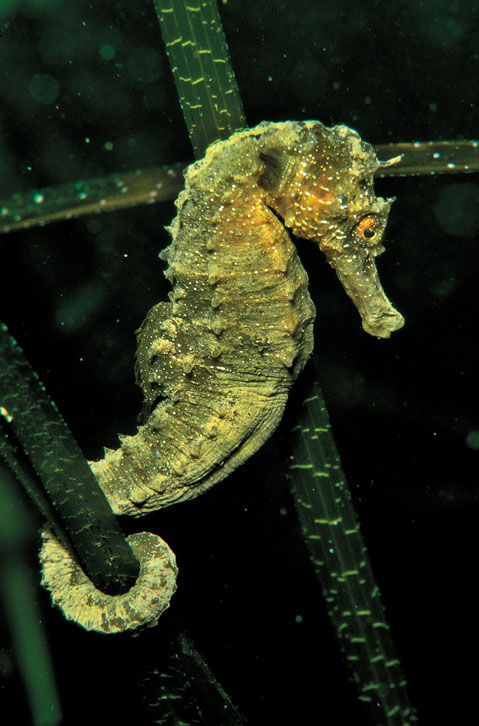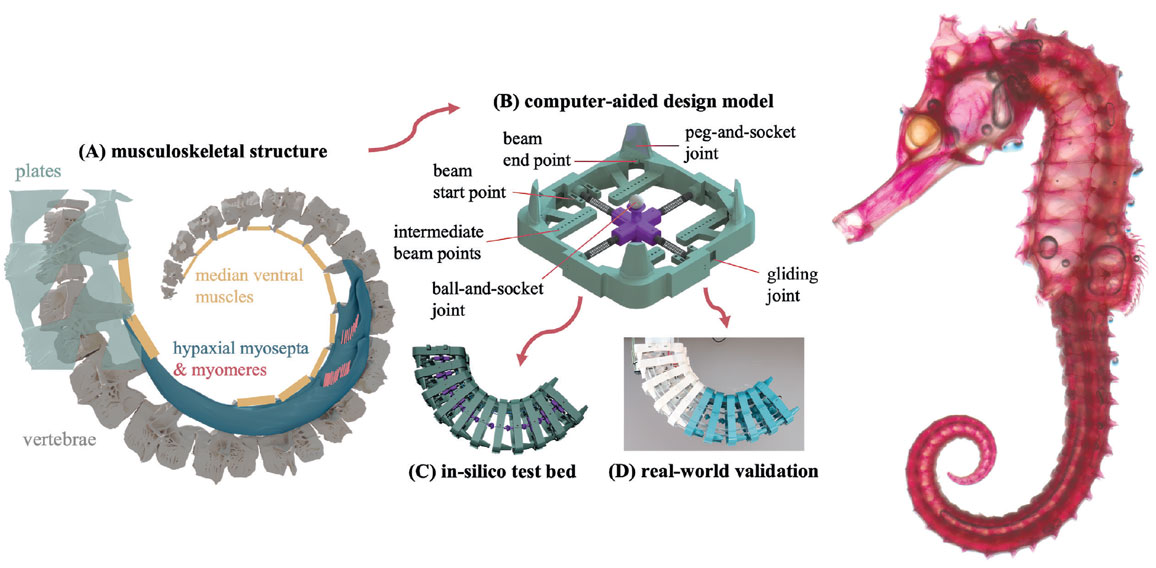Unfurling the Curl
By Fenella Saunders
The tail muscles of seahorses differ from those of most other prehensile animals.
The tail muscles of seahorses differ from those of most other prehensile animals.

Buffeted by strong currents, trying to hide from predators, a diminutive seahorse grasps onto a blade of seagrass in the shallow ocean. It uses its prehensile tail to hold on tightly as it blends in with its environment, staying anchored as it waves back and forth like the grass it’s attached to.
Biologist Dominique Adriaens of Ghent University in Belgium and his colleagues study the morphology and biomechanics of seahorses, from how they feed to the shapes of their tails. The team took numerous computed tomography (CT) scans to look at the creature’s armored structure, made up of bony plates surrounding their muscles and central vertebrae. The researchers realized that the seahorse tail muscles were unusual: In closely related species, such as pipefish (which do not have prehensile tails) and pipehorses (which can curl their tails but lie only horizontally), the tail muscles are short, spanning no more than three vertebrae segments. But in seahorses, the tails have additional long muscles that span up to 11 vertebrae.
To figure out why seahorses had evolved this specific muscle structure in their grasping tails, the team turned to computer modeling, so they could see how the tails would be affected by different muscle lengths. “We cannot use a biological system, because all seahorses have that weird configuration,” Adriaens said. “The nice thing about computer models is that you can say, What if the muscle spans only three segments? What if it spans five segments?”

Pascal Kobeh/Nature Picture Library
The researchers developed a simplified, scaled-up virtual model of the seahorse tail. They also made a 3D print of the model tail, using a retractable wire to mimic muscle contraction (see videos below). By trying out different muscle attachment points and lengths, as they recently reported in the journal Interface, they showed that the longer muscles produce more torque than the short ones. Also, they found that the long muscles tend to follow the same axis as the tail, whereas the short ones tend to pull more to the sides, diminishing their effectiveness. “By making the muscles longer and spanning more vertebrae, the muscles also come to lie in the plane where more of the contraction force is translated into bending force,” Adriaens explained.

D. Marzougui, et al. 2025. Interface 22:20240876/Dominique Adriaens
The models also showed that the long muscles help the tail twist while also getting a good grip, which allows the seahorses to keep their upright posture while gripping vertical blades of grass, corals, or mangrove roots (see second video below). “A seahorse that swims vertically and wants to attach to something that is vertical has to turn its tail sideways,” Adriaens says. “The model showed that with a very simple configuration of left and right muscle pulling, you can already generate the kind of sideways motion that seahorses use.”
That twisting motion might be the key to when seahorses emerged: The team speculates that the animals might have evolved because of the developing seagrass environment in the Oligocene epoch, some 30 million years ago. “It could be that it all has to do with this vertical position, because that’s the main point where seahorses differ from the pipehorses,” Adriaens says. “Maybe it’s indeed the capacity to do this lateral side bending to hold on to vertical objects that was the main selective pressure.”
Adriaens and his team think that the long muscles might also require less neurological control. “We already looked a bit at the brain of seahorses and compared it with pipefish, and they don’t have a spectacularly different brain,” Adriaens says. So the long muscles in seahorses might give them more torque capacity without needing additional neurological resources.
Most other animals with prehensile tails, such as primates and chameleons, don’t have these long muscles. Only a few mammals, such as binturongs and kinkajous, do. “Seahorses don’t hang upside down, and they have hydrostatic pressure that keeps them up, so they don’t need a very powerful system, which could explain why they have something different,” Adriaens says.
The bony plate armor of seahorses may also have influenced their muscle evolution. As the muscles contract, they shorten and bulge, but their volume is constrained by the plates. As a result, the whole tail stiffens, which helps it to hold on. “I’m convinced that without the body armor, this long musculature would never have emerged,” Adriaens says. “It wouldn’t make sense if the attachment points were pulling on the skin, which would just deform instead of properly transferring the forces.”
These studies also refute prior theories about the roles of these muscles. Some experts thought that the long muscles were for quick grabs whereas the short muscles held on for long periods, but these newer results indicate it’s more a case of them working together. “If you see a seahorse in action, there’s not that much bursting movement happening,” Adriaens explains. “They’re actually pretty slow.”

D. Marzougui, et al. 2025. Interface 22:20240876
To learn more, the team next plans to build models that taper toward the end, and to study the joints between the bony plates. Such insights could help the seahorse’s biomechanics find application in robotic devices. Adriaens and his colleagues envision possible applications in microsurgery, flexible splints that allow selective immobilization, or a robotic arm that could help lift patients. Adriaens notes that it feels like a full-circle moment to apply seahorse biomechanics to robotic technology, because such technology allowed them to create the models used in this study. “Without these engineering tools,” he says, “we could never have tested these hypotheses on adaptive evolution in a biological system.”
Click "American Scientist" to access home page
American Scientist Comments and Discussion
To discuss our articles or comment on them, please share them and tag American Scientist on social media platforms. Here are links to our profiles on Twitter, Facebook, and LinkedIn.
If we re-share your post, we will moderate comments/discussion following our comments policy.